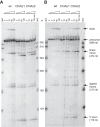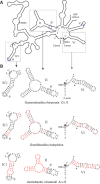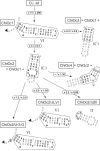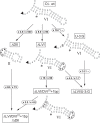Activating the branch-forming splicing pathway by reengineering the ribozyme component of a natural group II intron
- PMID: 26769855
- PMCID: PMC4748821
- DOI: 10.1261/rna.054643.115
Activating the branch-forming splicing pathway by reengineering the ribozyme component of a natural group II intron
Abstract
When assayed in vitro, group IIC self-splicing introns, which target bacterial Rho-independent transcription terminators, generally fail to yield branched products during splicing despite their possessing a seemingly normal branchpoint. Starting with intron O.i.I1 from Oceanobacillus iheyensis, whose crystallographically determined structure lacks branchpoint-containing domain VI, we attempted to determine what makes this intron unfit for in vitro branch formation. A major factor was found to be the length of the helix at the base of domain VI: 4 base pairs (bp) are required for efficient branching, even though a majority of group IIC introns have a 3-bp helix. Equally important for lariat formation is the removal of interactions between ribozyme domains II and VI, which are specific to the second step of splicing. Conversely, mismatching of domain VI and its proposed first-step receptor in subdomain IC1 was found to be detrimental; these data suggest that the intron-encoded protein may promote branch formation partly by modulating the equilibrium between conformations specific to the first and second steps of splicing. As a practical application, we show that by making just two changes to the O.i.I1 ribozyme, it is possible to generate sufficient amounts of lariat intron for the latter to be purified and used in kinetic assays in which folding and reaction are uncoupled.
Keywords: group II intron; lariat intron; linear intron; self-splicing.
© 2016 Monachello et al.; Published by Cold Spring Harbor Laboratory Press for the RNA Society.
Figures









Similar articles
-
Transitions between the steps of forward and reverse splicing of group IIC introns.RNA. 2020 May;26(5):664-673. doi: 10.1261/rna.075044.120. Epub 2020 Mar 3. RNA. 2020. PMID: 32127385 Free PMC article.
-
Crystal structures of a group II intron lariat primed for reverse splicing.Science. 2016 Dec 2;354(6316):aaf9258. doi: 10.1126/science.aaf9258. Science. 2016. PMID: 27934709
-
A chemical phylogeny of group I introns based upon interference mapping of a bacterial ribozyme.J Mol Biol. 2000 Sep 15;302(2):339-58. doi: 10.1006/jmbi.2000.4056. J Mol Biol. 2000. PMID: 10970738
-
Group II intron lariat: Structural insights into the spliceosome.RNA Biol. 2015;12(9):913-7. doi: 10.1080/15476286.2015.1066956. RNA Biol. 2015. PMID: 26121424 Free PMC article. Review.
-
Group II Intron Self-Splicing.Annu Rev Biophys. 2016 Jul 5;45:183-205. doi: 10.1146/annurev-biophys-062215-011149. Annu Rev Biophys. 2016. PMID: 27391926 Review.
Cited by
-
Protein-free catalysis of DNA hydrolysis and self-integration by a ribozyme.Nucleic Acids Res. 2025 Jan 11;53(2):gkae1224. doi: 10.1093/nar/gkae1224. Nucleic Acids Res. 2025. PMID: 39698822 Free PMC article.
-
Transitions between the steps of forward and reverse splicing of group IIC introns.RNA. 2020 May;26(5):664-673. doi: 10.1261/rna.075044.120. Epub 2020 Mar 3. RNA. 2020. PMID: 32127385 Free PMC article.
-
A Highly Proliferative Group IIC Intron from Geobacillus stearothermophilus Reveals New Features of Group II Intron Mobility and Splicing.J Mol Biol. 2018 Aug 17;430(17):2760-2783. doi: 10.1016/j.jmb.2018.06.019. Epub 2018 Jun 15. J Mol Biol. 2018. PMID: 29913158 Free PMC article.
-
Mechanisms of catalytic RNA molecules.Biochem Soc Trans. 2021 Aug 27;49(4):1529-1535. doi: 10.1042/BST20200465. Biochem Soc Trans. 2021. PMID: 34415304 Free PMC article. Review.
-
Structural Insights into the Mechanism of Group II Intron Splicing.Trends Biochem Sci. 2017 Jun;42(6):470-482. doi: 10.1016/j.tibs.2017.03.007. Epub 2017 Apr 21. Trends Biochem Sci. 2017. PMID: 28438387 Free PMC article. Review.
References
-
- Adamidi C, Fedorova O, Pyle AM. 2003. A group II intron inserted into a bacterial heat-shock operon shows autocatalytic activity and unusual thermostability. Biochemistry 42: 3409–3418. - PubMed
Publication types
MeSH terms
Substances
LinkOut - more resources
Full Text Sources
Other Literature Sources
Research Materials
